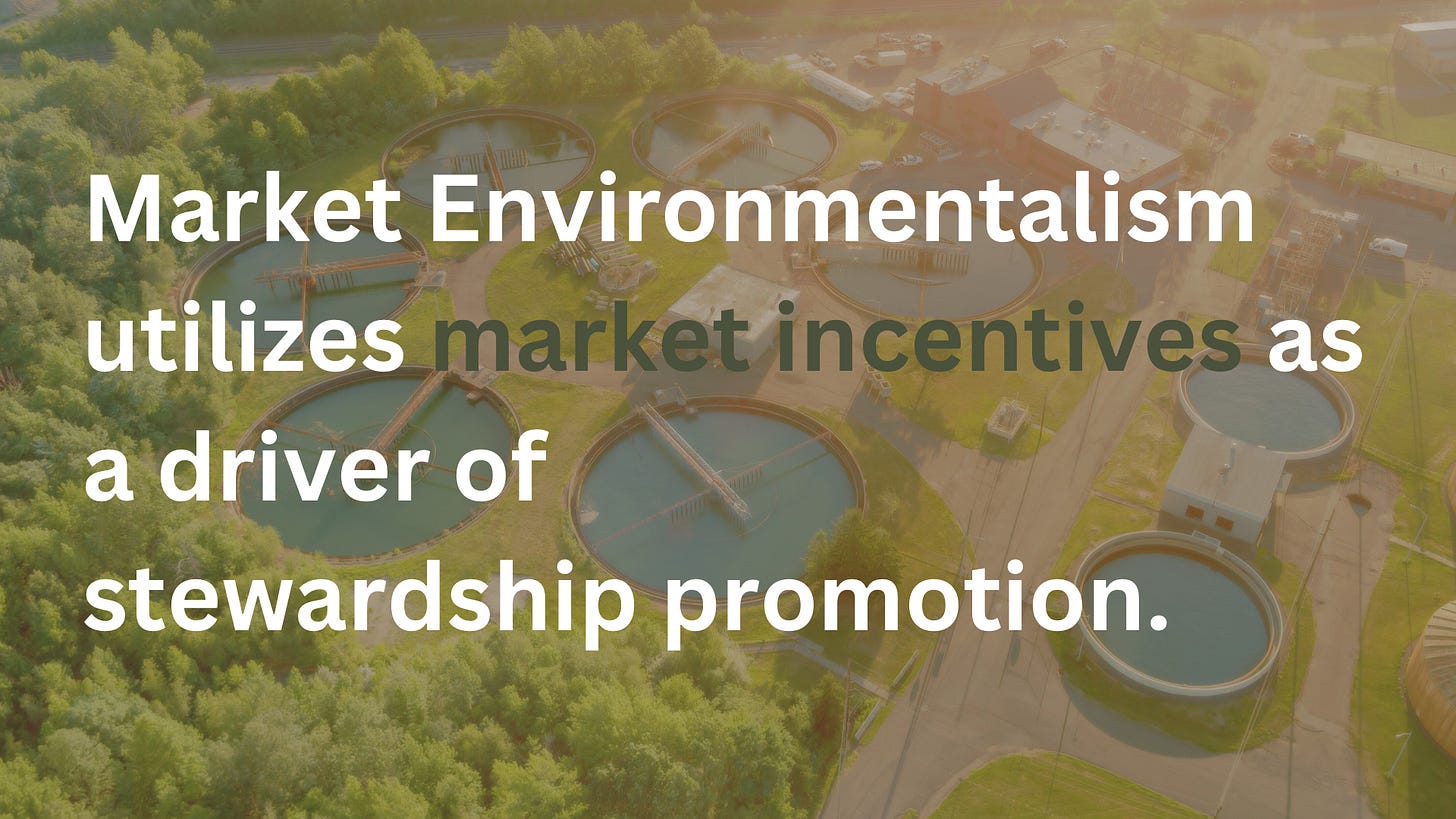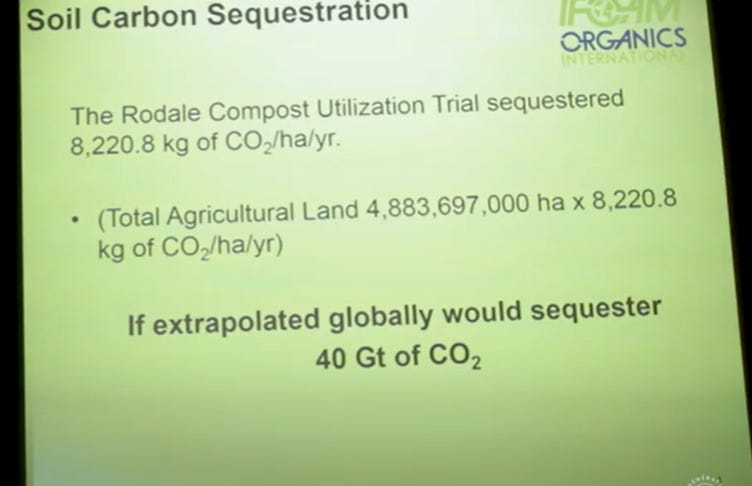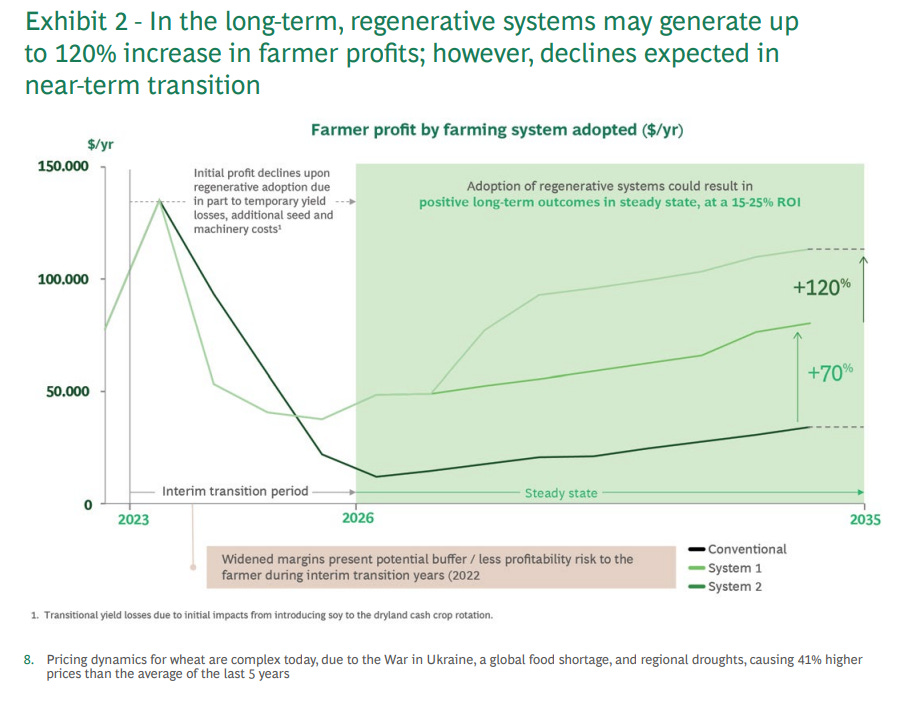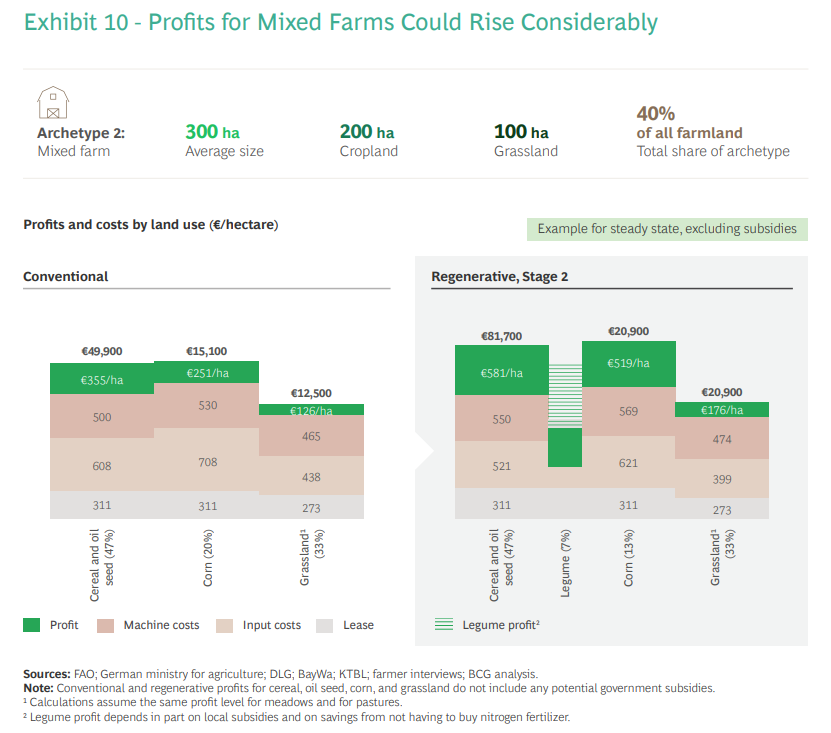How Regenerative Agriculture can Solve the World's Carbon Emissions Challenge, Enhance Farm Profitability and Enhance Human Health - all at once
We show the math calculations on carbon emissions ... Market Environmentalism - solutions must make sense financially, economically and environmentally .. how we are investing in this space
Imagine solving the world’s carbon emissions challenge without resorting to carbon taxes, carbon credits, lockdowns, or draconian restrictions on personal liberties and freedoms.
Imagine also enhancing human health at the same time with the same solution.
And imagine enhancing the profitability of businesses involved with implementing this solution.
So what is Regenerative Agriculture and how can it bring about this Hat Trick of meeting these three goals.

What Is Regenerative Agriculture?
Regenerative Agriculture is far more than being sustainable. It is a synergistic set of farming systems which use technologies and processes to increase soil organic carbon. Meaning carbon sequestration through the making soil better.
This set of agricultural systems encompasses agroecology, organic, permaculture, ecological agriculture, holistic grazing, biological agriculture, organic agriculture and agroforestry.
When we apply our unique approach of Market Environmentalism through Regenerative Agriculture, we get the Hat Trick described above. The four principles of Market Environmentalism are:
1. Market Economy: Economic and environmental success are not mutually exclusive. Only the market economy’s dynamic nature incentivizes entrepreneurs to do “more with less” and to create innovations that limit our ecological footprint.
2. Private Property Rights: Property rights provide the incentives for both environmental sustainability and accountability. That which no one owns, no one cares for.
3. Decentralization: Decentralizing power from government bureaucracies to local communities fosters closer cooperation, resource management, and environmental accountability.
4. Optimism and Innovation: We must embrace optimism and the power of innovation to achieve real change. Humans are not a plague on the planet but rather the “ultimate resource,” capable of bringing forth innovative ideas and solutions to protect our environment. Environmental challenges can be solved through innovation, technological progress, and entrepreneurship—while rejecting alarmist and unscientific approaches.
Market Environmentalism is all about solutions that make sense financially, economically and environmentally.
Agenda-based Approaches Won’t Work
Why do we take a Market Environmentalism approach - because agenda-based approaches generally do not work at all, are not sustainable or only work marginally or short-term:
Approaches requiring government subsidies. These approaches rely on continuing government funding, programs or donations which are not sustainable and do not generally make for an overall viable business case.
Approaches requiring carbon taxes and carbon credits. These approaches are based on an underlying forgiveness absolving the sins carbon emissions. Why not stop or truly environmentally sequester the carbon emissions in the first place? Why have individuals and businesses pay more taxes or pay to buy carbon credits? These approaches not only do not make sense financially and economically, but also they do not make sense environmentally.
Approaches requiring lockdowns or restrictions. These approaches generally do not go well with individuals and businesses as they not only restrict freedoms and liberties, but also generally cause a loss or slowing of economic growth or economic activity, and a fall in the standard of living.
Approaches relying on encouraging changes in human behavior. Human nature never changes. Why have to rely on encouraging changes in purchasing preferences or economic choices, especially when these changes either don’t make sense financially or economically, or don’t make sense environmentally?
The Math Behind Regenerative Agriculture Solving the World’s Carbon Emissions Challenge
While the question is debatable of whether carbon emissions put into the atmosphere by human and industrial activity is a bigger factor than the macro factors of volcanoes, solar cycles, and other natural warming or cooling processes, we do take the approach that it is best to minimize industrial effluents, such as carbon emissions, caused by human and industrial activity into the land, water or air. Most scientific studies, performed with no agendas or conflicts of interest, indicate that the carbon emissions from the macro factors are much bigger than the human and industrial activity factor - and with causation the other way around, meaning natural macro factor warming processes cause the release of carbon from the world’s oceans, thereby increasing carbon into the air over hundreds of years timeframes.
So let’s look for a solution to negate out all the carbon emissions from human and industrial activity.
The Solution is in the Soil

The soil of the earth, along with trees and plants are the largest sink or depository for carbon after the oceans. As such it makes sense to leverage this ability of the earth to address the carbon emissions challenge of reducing carbon emissions going into the environment from human and industrial activities.
Regenerative organic agricultural practices sequester CO2 and store it in the soil and above ground as organic matter. Perennial polycultures, agroforestry, and reforestation can sustain and increase both above ground and below ground carbon.
Scaling up a small percentage (5-10%) of best practice regenerative and organic systems will result in billions of tons (Gt) of CO2 per year being sequestered into the soil and into continuous, perennial above ground biomass. The identification, funding, and deployment of these best practices on 5-10% or more of the world’s total croplands (4 billion acres), rangelands (8 billion acres), and forestlands (10 billion acres) will be more than enough to draw down and cancel out all the current CO2 and greenhouse gases (43 Gt of CO2) that are currently being emitted, without putting any more CO2 into the atmosphere or the oceans.
Currently when carbon dioxide CO2 is released into the atmosphere from the burning of fossil fuels or destructive agriculture or land use practices (currently 43 Gt of CO2 emissions per year), approximately 50% of these 43 Gt of CO2 emissions remain in the atmosphere (21.5 Gt of CO2 annually), while 25% is absorbed by land, plants, and trees (10.75 Gt CO2), and the remainder 25% (10.75 Gt CO2) is absorbed into the ocean. Therefore, we need to begin to draw down 32.25 Gt CO2 (and eventually more) of current total emissions (in conjunction with the conversion to alternative energy and energy conservation), in order to reach net zero emissions (eliminate or cancel out all the emissions going into the atmosphere and the oceans). We will need a net drawdown of 32.75 Gt as soon as possible since 10.75 Gt is already being sequestered by our soils and forests. Once we stop putting more CO2 into the oceans (and the atmosphere), while continuing down the path of alternative energy and regenerative agriculture and land use, the oceans, soils, and biota will be able to draw down evermore significant amounts of the legacy (excess) carbon in the atmosphere, which, in turn, will begin to steadily reduce global warming. - Source link
The above numbers were written in 2021. Here are some more recent updated numbers - link here and here:
So what is the math behind using the soil to sequester the total amount of added carbon emissions put into the air by human and industrial activity?
Watch the video by Regeneration International’s leader Andre Leu - link here or watch below:
Here is a summary of the math:
total ppm currently of carbon in atmosphere is about 421 ppm
annual growth is about 2 ppm from human and industrial activity
1ppm of CO2 = 7.76 Gt of CO2
15.52 Gt CO2 / year needed to stabilize CO2
if soil health improved to all farmland globally would allow soil sequestration to increase by 40 Gt CO2 / year - but we only need 15.52 Gt to negate all of it
also there are rangelands in addition to farmland, estimates for allowing soil sequestration to increase on rangelands is 98 Gt CO2 / year = again, only need to do a % of this to get to 15.52 Gt
See also this link for comparable estimates from the Rodale Institute.
References for the above calculation:
So the next question is how do we enhance soil health to get to these numbers? Let’s explore now.
How to Enhance Soil Health through Market Environmentalism
Enhancing soil health can be done in many ways
Enhancing processes through improvements in farming and grazing best practices researched and detailed by various organizations including Regeneration International.
Applying technologies including Artificial Intelligence (AI)-based applications.
Here are some areas for enhancement and technology application below - source link here from Happy Future AI:
Precision Agriculture
Precision agriculture involves using technology to monitor and manage crop growth with high accuracy. AI-powered sensors, drones, and satellite imagery can collect data on soil health, crop conditions, and weather patterns. This data allows farmers to make informed decisions about planting, irrigation, and fertilization.
For instance, machine learning algorithms can analyze soil samples to determine nutrient deficiencies and recommend tailored amendments. AI can also predict pest outbreaks and suggest timely interventions, reducing the need for chemical pesticides.
Soil Health Monitoring
Healthy soil is the cornerstone of regenerative farming. AI can help monitor and enhance soil health through various means. Soil sensors equipped with AI algorithms can measure soil moisture, temperature, pH levels, and microbial activity. These sensors provide continuous data, enabling farmers to track changes and implement corrective measures promptly.
AI-driven soil health platforms can also analyze historical data and predict future trends. This predictive capability helps farmers plan crop rotations, cover cropping, and other regenerative practices to maintain soil fertility.
Crop Diversification and Rotation
Crop diversification and rotation are key principles of regenerative farming. Diverse cropping systems improve soil health, reduce pest pressure, and enhance ecosystem resilience. AI can assist farmers in planning and implementing diverse crop rotations.
By analyzing data on soil conditions, climate, and market demand, AI algorithms can recommend optimal crop sequences. This ensures that the soil remains fertile and productive year after year. Additionally, AI can help identify companion planting combinations that enhance biodiversity and natural pest control.
Livestock Integration
Integrating livestock into farming systems is a hallmark of regenerative agriculture. Managed grazing mimics natural herbivore movements, promoting soil health and biodiversity. AI can optimize livestock management by tracking animal behavior, health, and grazing patterns.
AI-powered collars and sensors can monitor livestock movements and grazing intensity. This data helps farmers rotate pastures effectively, preventing overgrazing and ensuring even nutrient distribution. AI can also detect early signs of illness in livestock, enabling timely interventions and reducing reliance on antibiotics.
PastureMap is an AI-driven grazing management platform that helps ranchers optimize pasture utilization. By tracking livestock movements and grazing patterns, PastureMap ensures that pastures are grazed evenly, promoting soil health and biodiversity.
Economic Benefits
Increased Yields and Profitability: Precision agriculture and optimized management practices lead to higher crop yields and reduced input costs. A study by the World Economic Forum estimates that widespread adoption of precision agriculture could increase global agricultural productivity by 25%.
Reduced Input Costs: AI-driven recommendations for fertilizers, pesticides, and water use reduce the reliance on costly chemical inputs. This translates to significant cost savings for farmers.
Market Premiums: Consumers are increasingly willing to pay a premium for sustainably produced food. Regenerative farming practices, verified through AI monitoring, can command higher prices in the market.
Risk Mitigation: Diversified cropping systems and predictive analytics reduce the risk of crop failures and market volatility. This enhances the financial stability of farming enterprises.

Also in addition to the above, read our posting on how to use AI-based process mining and discovery tools to reduce carbon emissions - link here. This technique can be applied to all business processes for a farm or ranch. Contact us to help - we can provide this service - info@cedarportfolio.com.
Ok all well and good .. but the next question is how can all this be done in a way that makes sense economically and financially, in particular for farmers, agribusinesses and ranchers (for grazing lands enhancements)? And can it be scaled to cover increasing levels of agricultural production? In other words, is there a business case and how to transition farmlands and rangelands in a way that makes sense financially and economically?
Business Case
Well one to approach the business case questions is to educate and encourage consumers through studies indicating how applied regenerative agriculture can enhance human health, enough to justify higher prices for organic produce etc. Here are two slides from Andre Leu’s presentation which take this approach:

Ideally we need a business case approach with these elements:
Minimal or no use of pesticides and herbicides on farmlands and rangelands.
Ability for farmers, agribusinesses and ranches to maintain or increase their net profit and not rely on getting higher prices for their products, and not rely on getting revenues from carbon credits or government subsidy programs.
Here are materials to help farmers, agribusinesses and ranchers on maintaining or enhancing net profit through regenerative agriculture - here and here.
Adjusted Crop Insurance
Regeneratively-grown crops can command adjusted crop insurance terms that can help as a long-term support lever.
Leveraging from the Business Case for Regenerative Agriculture in Germany
The Boston Consulting Group (BCG) and NABU (Nature And Biodiversity Conservation Union) have put together a great informative and insightful business case for Regenerative Agriculture, done with a focus on Germany - but the results can essentially be applied anywhere else as well. Here are two links - here and here. Click on these click to view enlarged images of the charts below.
Here are some highlights from the studies:
The chart below provides insights and suggestions for addressing the transition into enhancing regenerative agricultural practices across farm structure, inputs put on land/crops and how land can be cultivated:
The chart below provides insights and suggestions of when to apply regenerative agricultural practices in the crop cycle, comparing conventional agriculture to regenerative agriculture:
The chart below quantifies how regenerative agriculture processes map to enhancements in farm profitability:
The charts below illustrates how the initial up-front 3 year transitional costs (assuming no income such as carbon credits, subsidies or additional revenues from the ability to command higher prices for regenerative or “organic” products) when transitioning from conventional agriculture to regenerative agriculture are quickly recovered and begin generating enhanced farm profitability over the medium-term and the long-term:
System 1/System 2 definitions are as follows:
We provide research and consulting services - contact us to help your farm, agribusiness or ranch to develop a full business case and transition migration strategy - info@cedarportfolio.com. This includes guidance and preparation towards international certification in the transition to regenerative agriculture.
Transitioning to Regenerative Agriculture
The Business Case documentation above on Germany provides a great deal of information on how to transition from conventional agriculture to Regenerative Agriculture. In addition, third-party independent Quality Assurance International (QAI) offers a Certified Transitional.

Quality Assurance International (QAI) was founded in 1989 and began certifying agricultural products to the California standard as there was then no national organic standard. Due to the complicated and evolving state of the standard at that time, QAI established itself by taking a methodical and regulatory approach to the certification process. Claims on organic or Regenerative Agriculture can only be guaranteed through rigorous verification, inspection and assurance practices.
Through our research and consulting services, we can provide consulting services to identify the best of breed AI applications as well as integrate QAI certifications and overall project management and implementation.
How we are Investing in Regenerative Agriculture
And now we elaborate here below on how we are investing in this space of Regenerative Agriculture …





























